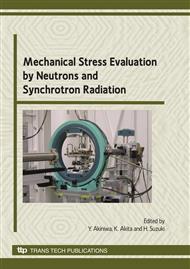p.111
p.116
p.123
p.129
p.133
p.139
p.143
p.149
p.155
Size and Strain Analysis of Deformation Microstructure in High-Nitrogen Austenitic Stainless Steels
Abstract:
Deformation microstructure of Fe-18Cr-10Mn alloys with different nitrogen content (0.39 and 0.69N) were investigated using neutron diffraction. The deformation mode changed from strain-induced martensitic transformation (SIMT) to deformation twinning (DT), as nitrogen content was increased. The measured neutron profiles of tensile-strained bulk samples were fitted by modified Thomson-Cox-Hasting profile-shape function and the Lorentzian and Gaussian integral breadths were calculated based on Rietveld refinement. With the calculated integral breadths, the mean-squared (MS) strain could be evaluated using the size and strain analysis of double-Voigt approach. Based on the analysis of peak shift of individual reflections, the stacking fault probability (SFP) was determined. Although the calculated SFP and MS strain varied with the degree of deformation, the ratio of MS strain to SFP remained constant for each alloys regardless of tensile strain, but increased with nitrogen content. As a result, it was found that the SFE increased with increasing nitrogen content. The nitrogen-induced transition of deformation microstructure was accounted for by the change in SFE, as reported in other fcc materials.
Info:
Periodical:
Pages:
133-138
Citation:
Online since:
May 2010
Authors:
Price:
Сopyright:
© 2010 Trans Tech Publications Ltd. All Rights Reserved
Share:
Citation:


